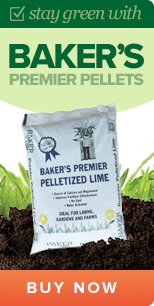Should I Apply Lime, Seed or Fertilizer to My Lawn First?
Table of Contents
Author/Reviewed By: Josh Miller, Sales Manager: Baker Lime & North America Minerals
Published: 3/3/2017 – Updated: 10/25/2023
In general, it’s best not to apply lime, seed and fertilizer at the same time. You typically want to apply agricultural lime before fertilizer for acidic soil, or fertilizer before lime for nutrient-deficient soil. Seed comes after either one or both. Whether you’re growing a lush green lawn or productive crop field, a duo of lime and fertilizer — or a lime, seed and fertilizer application in the right order for the intended plantings — can help you maintain optimally fertile soil.
How do fertilizer and lime work? Can you apply lime and fertilizer at the same time? Which one should you apply first and when is the best time to spread lime on lawns? Read on to learn more about fertilizer and lime application techniques.

Why Fertilizer Is Important
Fertilizer is essential to growing healthy plants, bountiful crops, thick lawns and beautiful gardens. Simply put, most gardeners and farmers don’t use enough fertilizer, as it’s often thought of as an optional step. Plants require six nutrients in order to grow: carbon, hydrogen, oxygen, nitrogen, phosphorous and potassium.

As you may recall from science class, plants receive carbon, hydrogen and oxygen through photosynthesis, thanks to a healthy diet of air, water and sun. The remaining required nutrients, nitrogen, phosphorous and potassium are found in soil.
What many people who are not chemists or biologists forget, though, is these plant nutrients do not renew in the soil without the addition of fertilizer. Year after year, plants consume the nutrients present in the soil, and these nutrients eventually need to be replaced. Fertilizer helps to bring these essential ingredients back into the equation.
Each nutrient brings something different to the table. Nitrogen is a major component of chlorophyll and is, therefore, an essential part of the photosynthesis process. An even balance of nitrogen leads to thicker and taller stems, healthier leaves, colorful flowers and bountiful fruit. Nitrogen can also speed up the process of plant growth.
Phosphorous is also part of chlorophyll, and it helps with the development of sturdy roots, thanks to the increased production of oils and starches. Phosphorous leads to improved flower formation, increased seed production and a heartier resistance to plant diseases as well.
Potassium is another important element with a wide range of benefits that help the overall health quality of the plant. Potassium increases crop yields by improving root growth, building essential proteins and combatting harmful diseases.
Not only does fertilizer renew the soil with these nutrients, but it also allows for a greater flow of air through the soil and increases the soil’s ability to retain water. Fertilizers provide plants with additional nutrients, too, including calcium, sulfur, magnesium, boron, copper and iron.
Overall, fertilizer leads to healthier, thicker and quicker plant growth, and it should be an essential tool in every gardener or farmer’s arsenal.
Request A Quote On Our Lime Options!
What Is Soil Acidity?
Fertilizer has its many advantages, but these benefits cannot be properly realized without proper soil acidity. Acidity is a measure of the amount of hydrogen present in the soil and is graded by pH, or “power of hydrogen” value. pH is measured on a logarithmic scale that ranges from 0 to 14. A pH value of 7 is considered neutral. A substance with a pH value lower than 7 is considered an acid, and a substance with a pH value higher than 7 is considered an alkaline or base.
Keep in mind that a lower pH level means a higher concentration of hydrogen, and as the scale is logarithmic, each unit increase means a tenfold change in acidity. For example, soil with a pH value of 6 has ten times the hydrogen concentration of soil with a pH value of 7. Don’t worry — that’s the last math you’re going to have to do in this article.
Most soil ranges in pH value from 5.5 to 10.0. For healthy plant growth, a pH value between 6.0 and 7.0 is recommended. When the soil’s pH value falls below 6.0 there are several harmful side effects, including:
- Aluminum toxicity: Aluminum becomes soluble at low pH levels. Aluminum restricts root growth and limits the availability of water and plant nutrients.
- Nutrient availability: At high acidity, plants are unable to absorb nitrogen, phosphorous and potassium. This inhibits proper growth.
- Microbial activity: In acidic conditions, bacteria and fungi are unable to break down organic matter and cycle nutrients through the soil.
While acidic soil won’t destroy your plants or decimate your lawn, you won’t achieve maximum possible growth which is why you should test your soil. Fortunately, you can test the acidity level of your soil in a variety of ways. You can purchase an expensive, yet accurate commercial pH testing probe, a more affordable disposable pH testing kit or use any of a variety of DIY home-testing methods. Depending on your goals and budget, the dollar amount spent on soil testing can vary greatly. Learn more about the different soil types.
How Fertilizer Contributes to Soil Acidity

Soil acidity naturally increases over time thanks to an increasing concentration of hydrogen in the soil. Agriculture speeds up the process of acidification, largely through the use of ammonium-based fertilizers. Ammonium nitrogen from the fertilizer is converted into nitrate and hydrogen ions in the soil. If the nitrates are not properly absorbed by the plants, the nitrates leach away from the root zone, leaving behind hydrogen ions, which increase the acidity of the soil. It’s crucial to ensure plants are given an environment in which they can properly absorb nitrogen from fertilizers.
At a large scale, soil acidity is also caused by the sheer act of harvesting plants. Plants themselves are slightly alkaline, with a higher pH value. In a natural setting, when plants die, they decompose into the slightly acidic soil and restore a healthy pH balance. When plants are harvested, the cycle is broken, and the balancing act is never performed, leaving the soil slightly acidic.
How Agricultural Lime Helps Fight Soil Acidity

Lime is introduced both to supply calcium and to help restore the pH balance of soil. Liming is by far and away the most cost-effective solution for neutralizing soil, so it is used widely by farmers and gardeners everywhere.
Lime is made from ground limestone, a gray sedimentary rock composed primarily of calcium carbonate and magnesium carbonate, which are formed from the buildup of ancient organic remains. These components make lime rich in calcium and magnesium. These compounds are what neutralize the acidity of the soil.
As lime dissolves in soil, calcium rises to the surface of soil particles, replacing the acidic component of the soil. The acidic components, including hydrogen and potassium, react with the carbonate, leaving behind neutralized clay, carbon dioxide and water. As a result, you have neutralized soil that is able to foster proper plant growth.
How Is Lime Used?
Dolomitic lime is the most common type of agricultural lime sold for lawncare applications and is sold in the form of either powder or pellets. Lime powder is exactly what it sounds like: a fine, white powder you sprinkle over your lawn, garden or crop field. To apply lime powder to your lawn, you would typically use a drop spreader and tiller to ensure an even lime application.
When lime is more finely ground, you have an increase in surface area of the lime. This increase in surface area results in quicker reaction time with the soil.
The downside of lime powder is that it’s dusty and messy. It’s recommended to use a mask when applying the powder lime to your lawn as you should avoid breathing it in. The chemical properties of lime powder also give it a tendency to stick to driveways, patios and other paved surfaces, so it’s best not to apply it on a windy day.
As a result, many people prefer purchasing lime in pellet form. These pellets are easy to spread evenly across the ground. As they dissolve, they perform the same function as lime powder, breaking down into the soil. These pellets are specifically designed to effectively release lime quickly and evenly over time. Lime also varies in concentration to ensure the neutralizing value of the lime you purchase is at least 80%.
Should You Apply Lime or Fertilizer First?
In general, it’s best not to apply lime and fertilizer at the same time — but how do you decide whether to apply lime or fertilizer first?
The pH balance of your soil will largely dictate which of the two products you apply first. Keep in mind the goals of each growth supplement. Fertilizer is added to the soil to increase the nutrients available to plants, and lime is added to the soil to decrease acidity and make the nutrients easier and more accessible for plants to absorb. It’s crucial to take acidity into account when deciding between lime vs. fertilizer.
When to Apply Lime First
When applying agricultural lime, the objective is to get soil acidity to a reasonable level so plants can more effectively absorb the nitrogen and other nutrients found in fertilizer. If soil is overly acidic, plants cannot absorb nitrogen to the fullest potential. As mentioned before, unabsorbed nitrates that leach away from the plant root leave behind hydrogen ions, which can increase the acidity of the soil.
As a result, you want to ensure the soil has reached an appropriate pH balance before applying fertilizer. As a general rule, if your soil tests high in acidity, it’s best to apply lime before fertilizer. Soil with a neutral pH balance is the most effective use of your time and money spent fertilizing.
Anyone who works in the industry is often heard using the expression “lime takes time.” The deacidification process is not a quick one. The time it takes for lime to react with the soil is slow and dependent on several factors, including:
- The size of limestone particles
- Preexisting soil conditions
- How often and how widely the lime is applied
- The amount of lime added
- How well lime is integrated into the soil, rather than left sitting on the surface
The more finely ground the lime you use, the more quickly it will react with the soil, and the less time you will have to leave between liming and fertilizing. Certain lime pellets are also engineered to release quickly. If your soil is overly acidic, apply approximately 100 pounds of lime per 1,000 square feet of lawn. If lime is being added simply to maintain pH levels, it’s recommended to go with a lower amount — around 50 pounds of lime per 1,000 square feet.
Fall is generally considered the best time for applying lime, as it gives sufficient time for the slow chemical reaction to take place and avoids extreme heat or frost warnings.
For quicker results, the lime should be aggressively mixed at least 6 inches deep into the soil. If applied effectively, the pH-neutralizing effects of lime can start taking place by the 50-day mark. This is why it’s also recommended to apply lime before planting seeds. Thoroughly mixing the lime deep into the soil’s surface before planting seeds facilitates effective distribution of lime throughout your lawn’s entire surface.
When to Apply Fertilizer First
When planting new grass seed, or seeds of any variety, it’s best to apply fertilizer before lime. If nutrients are absent from the soil, the seeds will not be able to grow effectively. No matter what the acidity level of the soil, if no nutrients are present in the soil, plants won’t germinate to their fullest potential. In the case where you are at the seed-planting stage, it’s best to ensure soil is complete with proper nutrients.
Wait at least a week to ten days before applying lime. Once plants have been given appropriate time to start absorbing the nutrients present in the fertilizer, apply lime to the soil. The addition of lime will increase the effectiveness of the fertilizer already present in the ground. The plants’ roots, which should have started growing by this point, will enjoy the extra boost provided by the lime.
When It’s Okay to Apply Lime and Fertilizer at the Same Time
If your lawn or crop field’s pH level is already sufficiently neutral, there’s no need to apply fertilizer and lime at separate times. To save you time (and likely money), it’s okay to apply agricultural lime and fertilizer at the same time. The fertilizer with lime will provide an immediate supply of plant nutrients to the soil, and the lime will release slowly over time and maintain the appropriate pH balance. The effects of the lime are not needed immediately, so it’s not an issue that the effects of the lime come into play well after those of the fertilizer treatment.

To ensure a proper amount of both fertilizer and lime are applied evenly across your entire lawn surface, it’s recommended to apply them separately. Make an initial pass over the planting surface with fertilizer, and then repeat when adding lime.
Use Lime As a Fertilizer in Lawncare and Agriculture
If your lawn or crop field already has a neutral pH balance, it’s only necessary to apply lime once every two years. An excess amount of lime can result in iron chlorosis, which results in yellow or even dead grass. Over-applying fertilizer can result in chemical burns, thatch buildup and an increase of pests and diseases in your lawn.
When you need the best in AG-lime for your agricultural operation, trust us at Baker Lime. Our lime and fertilizer products combined with more than 125 years of experience give you what you need to help keep your grass, flowers, vegetables, fruit and more flourishing. Find and contact your local Baker Lime dealer for your AG-lime needs.
Related Resources:








